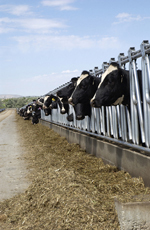 Higher culling rates have appeared to stem the robust buildup of dairy replacements by trimming inventories 41,000 head in January compared to last year's 4.57 million heifers. While that is welcomed news, heifer numbers are still running quite high with 49 heifers (500-plus pound heifers) for every 100 cows, the USDA recently estimated. That compares to 49.9 in January of 2011 and 49.8 in January of 2010.
Higher culling rates have appeared to stem the robust buildup of dairy replacements by trimming inventories 41,000 head in January compared to last year's 4.57 million heifers. While that is welcomed news, heifer numbers are still running quite high with 49 heifers (500-plus pound heifers) for every 100 cows, the USDA recently estimated. That compares to 49.9 in January of 2011 and 49.8 in January of 2010. One thing working in our industry's favor in keeping heifer numbers at bay is high cull cow prices. In the latest Agricultural Prices published by USDA, dairy and beef cull cows were fetching $73.80 per hundredweight (cwt.). That's up $3.30 from the previous month and up $8.80 from last January.
These record-high beef prices are encouraging dairy producers to ship older cows. Last year, we sent 2.91 million cows or nearly 32 percent of our dairy cow inventory to slaughter. That was the highest culling rate since 1997, and it represented an additional 107,000 head sent to stockyards compared to the prior year.
Prices for beef show no sign of decline. In the past two years, the U.S. became a net beef exporter. Strong demand and declining beef cattle numbers could push prices even higher in 2012.
While beef prices are fetching top dollar, dairy replacement prices are not nearly as strong. In July 2008, dairy replacement prices peaked at $1,990 and fell $750 to $1,240 just 15 months later. Today, prices are $530 off from the 2008 record highs at $1,460 per head.
On the flip side, the lower price for top-quality heifers has encouraged dairy export sales. Through November, the U.S. has exported 66,620 dairy replacements. Turkey is the top buyer. If the trend continues, the U.S. could end up exporting about 35,000 more head than last year. America isn't the only country sending dairy heifers overseas. China also imported 100,000 dairy replacements from Australia and New Zealand.








